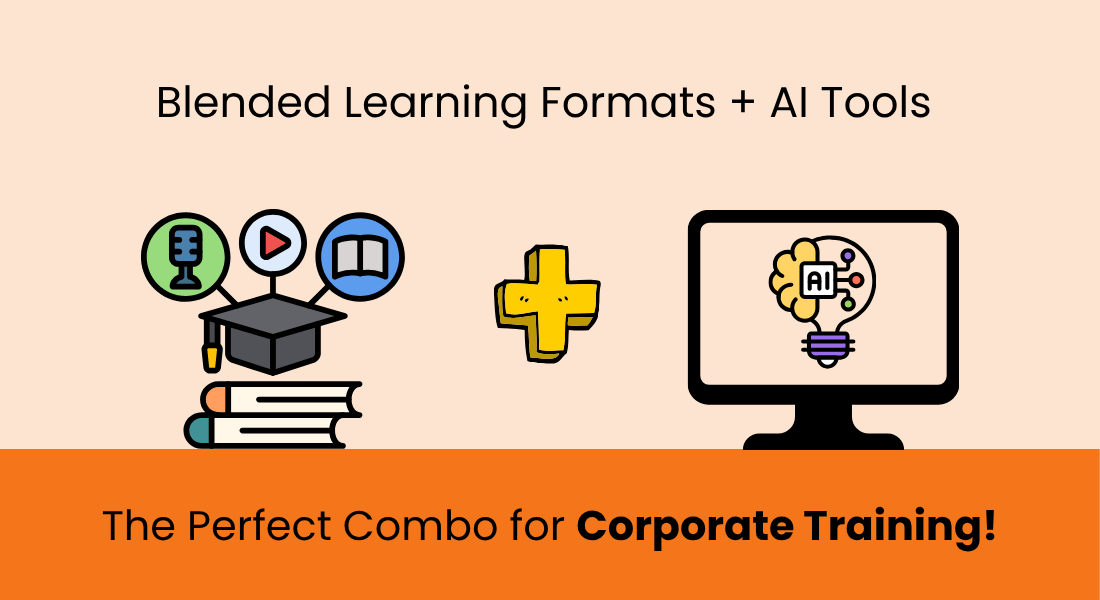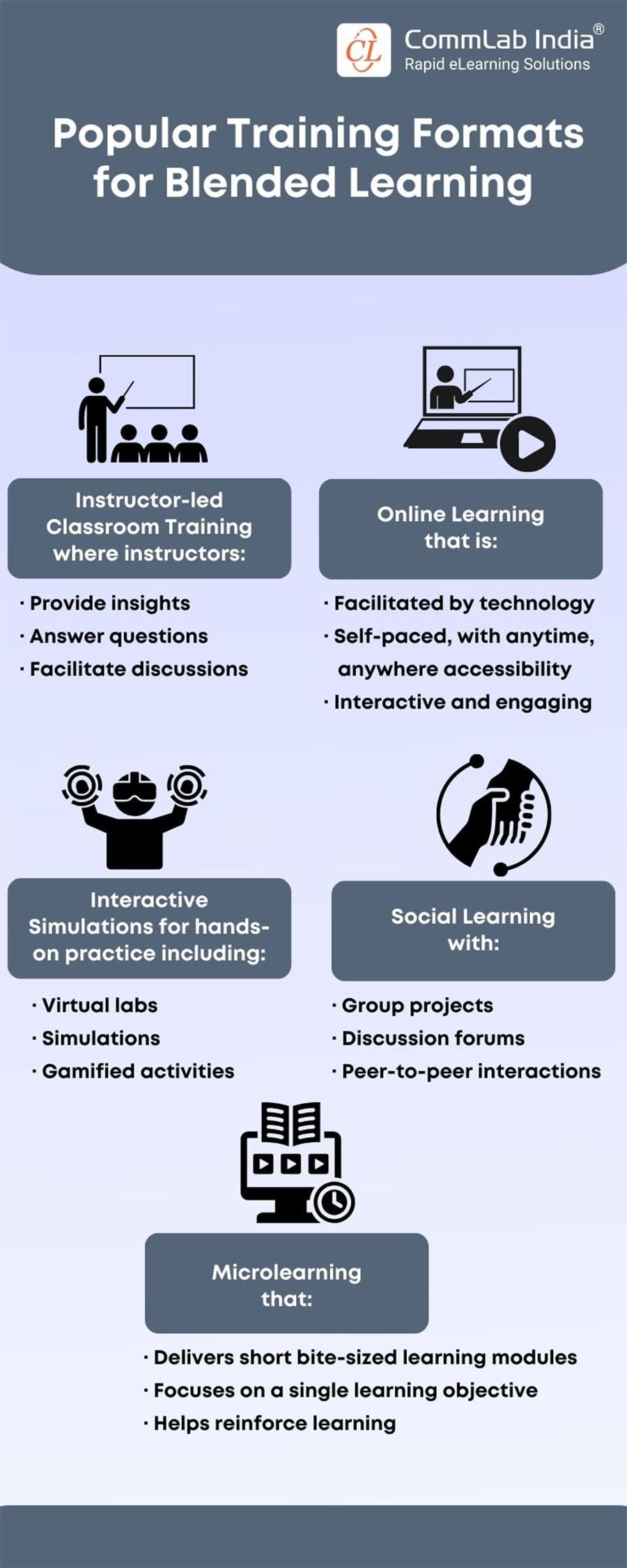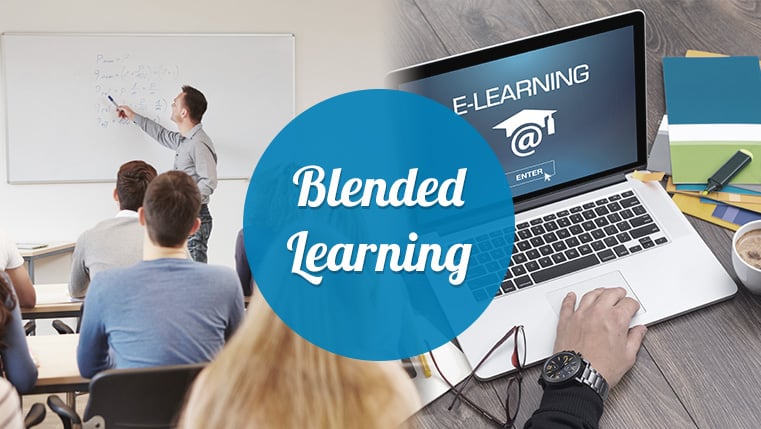How to Create Smarter Blended Learning Formats with AI Tools

For years, blended learning in corporate training meant juggling a mix of classroom sessions, online modules, and self-paced resources—carefully stitched together to create an engaging learning experience. This approach required significant time and effort, with learning paths being meticulously mapped out, content manually curated, and blended learning formats fine-tuned to address diverse learner needs. While effective, it was often a time-intensive process.
With the introduction of AI tools, blended learning has undergone a transformative shift. AI removes the guesswork from personalization by dynamically adapting content to each learner's pace and preferences. It automates repetitive tasks, recommends resources in real-time, and predicts learning gaps before they arise. This results in smarter, faster, and more impactful learning experiences, reducing the time required for design from weeks to just days.
→ Download Now: AI in Corporate Training
Table Of Content
- Blended Learning Formats: How do they Elevate Corporate Training?
- How do AI Tools Make Blended Learning Formats Easier to Develop?
- Which AI Tools Are Best for Developing Blended Learning Formats?
- Final Thought: AI is the Silent Power Behind Great Blended Learning
Blended Learning Formats: How do they Elevate Corporate Training?
Blended learning is transforming corporate training by combining online modules with in-person sessions, offering employees a flexible and engaging way to upskill. This approach caters to different learning styles, allowing participants to learn at their own pace online while benefiting from hands-on practice or discussions during in-person sessions. It ensures a personalized experience that boosts retention and application of knowledge.
Want to boost employee performance? Let's explore how blended learning can make a real impact.
For corporate teams, blended learning formats can be highly effective. Employees can absorb foundational concepts through digital content before attending interactive in-person sessions focused on collaboration and problem-solving. This balance of independent learning and group activities makes training more impactful and aligned with business goals.
Check out the infographic below for a breakdown of the most popular blended learning formats and how they work!
How do AI Tools Make Blended Learning Formats Easier to Develop?
How AI Tools Simplify Creating Different Blended Learning Formats?
AI tools are revolutionizing the development of blended learning formats by making the process faster, more efficient, and tailored by:
- Automating content creation, saving time and effort.
- Personalizing learning experiences to meet individual needs.
- Enhancing engagement with interactive and adaptive materials.
- Streamlining design and development for faster implementation.
Designing an effective blended learning approach can be complex, requiring careful planning, customization, and execution. This is where AI tools play a transformative role, streamlining the creation of various blended learning formats and enhancing the learning experience.
By leveraging AI tools, L&D teams can reduce the complexity of developing blended learning formats, ensuring employee training and development programs are not only efficient to create but also highly effective in driving employee growth and performance.
Which AI Tools Are Best for Developing Blended Learning Formats?
Live Blended Learning Formats in Corporate Training
Instructor-led (Classroom) Training
AI can transform face-to-face training sessions into data-rich experiences. AI tools like Google NotebookLM can enhance face-to-face training sessions by organizing and streamlining information. Trainers can use Google Notebook to take and share live notes during sessions, categorize key points with tags, and collaborate with participants in real time. After the session, Google Notebook can store and organize personalized learning materials, including follow-up resources or answers to participant questions, making it a powerful tool for continuous, tailored learning.
On-the-Job Training (OJT)
According to ATD's State of the Industry report, 55% of organizations emphasized on-the-job learning to a high or very high extent.
Whether it’s field engineers, retail staff, or healthcare workers, AI helps deliver real-time performance support. Smart glasses or mobile apps powered by AI can guide employees step-by-step, track their progress, and provide coaching tips based on contextual data. This is hands-on learning, enhanced with just-in-time intelligence, perfect for roles where mistakes are costly.
Social Learning in the Workplace
Discussion Boards & Online Forums
Corporate social platforms like Microsoft Viva Engage or Yammer now leverage AI to summarize discussions, recommend relevant threads, and even highlight SMEs (Subject Matter Experts) in the organization. Instead of getting lost in chatter, employees get a streamlined feed of high-impact knowledge-sharing. AI makes peer learning smarter, not noisier.
Virtual Collaboration: Synchronous
Live eLearning Classes
Virtual training tools like Zoom and Teams now come with AI-enhanced features like real-time transcription, auto-translation, and AI co-facilitators that answer FAQs in the chat. For global or hybrid teams, this means more inclusive sessions, personalized prompts, and data insights post-session on who might need more support.

AI in Corporate Training
Partner, Not Replacement
- AI in Corporate Training
- AI Toolkit for Super-charged Learning
- Challenges to Consider with AI Implementation
- And More!
Virtual Collaboration: Asynchronous
Email, Bulletin Boards, Online Communities
AI tools can now summarize lengthy email threads, flag action items, and even suggest content based on project context. Think MS Outlook with Copilot or Slack GPT—these integrations help employees learn in the flow of work, turning async channels into learning hubs, not noise centers.
Self-Paced Learning for Corporate Employees
Simulations and Scenarios
AI-powered eLearning authoring tools like Articulate Storyline 360 and iSpring Suite make it easy to create realistic scenarios and simulations. These tools allow you to design interactive, engaging learning experiences that replicate real-world challenges. Employees can practice decision-making, problem-solving, and job-specific tasks in a controlled environment, helping them stay engaged while focusing on skills that matter most to their roles.
Workbooks (Digital)
Digital workbooks become smarter with embedded AI chatbots that answer questions or offer hints in real time. Tools like Google Docs with AI suggestions help reinforce understanding without pulling the learner away from the task at hand.
Video and Audio Content
AI-powered video development tools like Synthesia and Vyond enable L&D teams to quickly create and edit corporate training videos, add captions, and design interactive chapters.
With AI tools like WellSaid Labs and ElevenLab, creating high-quality audio content has never been easier. These AI-powered platforms allow teams to generate professional voiceovers and audio materials to support corporate training programs, enhancing the overall blended learning experience.
Online Self-Assessments
Tools like Quizgecko generate adaptive assessments—meaning the questions get harder or easier based on how an employee performs. AI analytics reveal not just scores, but learning gaps, so future corporate training can be personalized at scale.
Performance Support Systems (EPSS) in Corporate Environments
Help Systems, Job-Aids, How-To Videos
AI-powered digital adoption platforms overlay training directly onto enterprise software. This means employees get guided walkthroughs, micro-help, or pop-up instructions without leaving their workflow, which is ideal for tools like Salesforce, SAP, or HubSpot.
Knowledge Databases
AI transforms internal wikis into conversational assistants. Using AI tools like ChatGPT Enterprise or MS Copilot, employees can ask natural-language questions and get precise answers pulled from policy docs, SOPs, or training manuals.
Mobile Applications
AI-powered mobile learning platforms send bite-sized lessons, nudges, or reminders—right when the employee needs them (e.g., before a sales call or compliance deadline). This turns downtime into productive microlearning moments.
Looking to boost corporate training with mobile learning? Here's how to create it effectively!
Performance or Decision Support Tools
In roles like customer support or operations, AI tools can suggest the next best action, recommend scripts, or flag risks. Think of a sales rep being prompted with real-time pricing insights or a support agent getting live resolution suggestions based on similar past tickets. This is where AI directly drives better business outcomes.
Final Thought: AI is the Silent Power Behind Great Blended Learning
In corporate training, blended learning is no longer just mixing modalities; it’s about creating fluid, intelligent learning ecosystems. AI adds that layer of context-awareness and responsiveness that modern workplaces demand. AI tools can support various blended learning formats, helping scale personalization, reduce time-to-competence, and keep learners engaged, all without overwhelming L&D teams.
Want to dive deeper? Download our free eBook to explore an AI toolkit for training design and development, challenges to consider during implementation, and how AI can seamlessly enhance your existing corporate training programs. Don’t miss out!







![Blended Learning: Busting Myths and Focusing on Facts[Infographic]](https://blog.commlabindia.com/hubfs/blogs/blended-learning-busting-myths-infographic.jpg)
